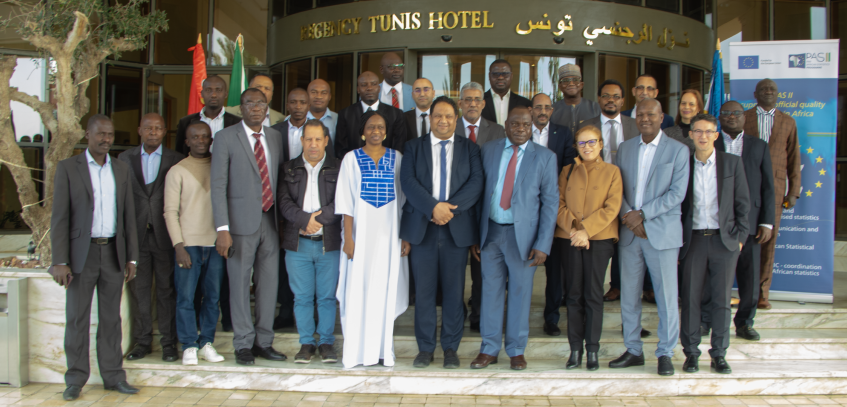Two back-to-back regional workshops held in Tunis in April 2025 have empowered over 35 statisticians from across Africa to integrate their Population and Housing Censuses (PHCs) with Agricultural Censuses (ACs), marking a new chapter in harmonised data production under the EU-funded PAS II programme.
The workshops, held from 8 to 11 April (Francophone) and 14 to 17 April (Anglophone), were organised by STATAFRIC, with support from Expertise France, under the Pan-African Statistics Programme II (PAS II) funded by the European Union and managed by Eurostat.
Opening the events, Mr. Adoum Gagoloum, Head of Economic Statistics Division at STATAFRIC, powerfully illustrated the urgency:
- Planning agricultural policies with 40-year-old data is like treating a patient with outdated X-rays. It’s time to update our statistical radiographs to reflect the reality of Africa today, says mr Gagoloum.
This call for transformation was echoed by over 60 participants from 16 countries, who explored practical strategies to link demographic and agricultural data, reduce duplication, and increase cost-efficiency.
Operational Highlights and Innovations Shared
Participants delved into international guidelines (FAO, UNFPA, UNSD), discussed institutional coordination, and shared success stories, including:
- Botswana: Integrated agricultural questions into the 2022 PHC, now used as a sampling frame for the 2025 AC.
- South Africa: Showcased a fully digital PHC, using CAPI/CAWI/CATI to improve coverage and precision.
- Sierra Leone: Demonstrated long-standing integration with PHC agricultural modules since 1995, supporting food security analysis.
- Senegal: Used a relevant agricultural module in its last PHC for generating up to date data on the structure of agriculture and sampling frame.
- Uganda: Shared gains from field team sharing and AI-driven demographic data analysis.
- Côte d’Ivoire: Developed digital training tools to support agents on the ground.
- Niger & Chad: Adapted survey tools to better cover nomadic and semi-nomadic populations.
- Each of these countries has shown that integration is not just possible—it is happening now, and it saves time, money, and effort, says Naman Keita, one of the workshop facilitators.
Strategic recommendations and next steps
The workshops generated a series of concrete recommendations for national and continental action, aligned with STATAFRIC and PAS II’s long-term vision:
For national statistical systems:
- Include agricultural modules in upcoming PHCs to ensure availability of up to date data on the structure of the agricultural sector and AC sampling frame.
- Strengthen collaboration between NSOs and Ministries of Agriculture through MoUs, joint technical teams or other country specific mechanisms where needed.
- Include a specific training session on agricultural modules during PHC enumerator training, and conduct the AC as soon as possible after the PHC whenever possible
- Conduct PHC and AC using digital tools (CAPI, GPS, cloud platforms) to modernise data collection for improved data quality and timely processing and release of census results.
- Document and disseminate pilot experiences to create reusable models for integration.
For STATAFRIC and PAS II:
- Contribute to technical assistance to countries to design and implement linked PHC and AC in collaboration with other Agencies such as FAO and UNFPA.
- Organise peer exchanges between leading countries (e.g., Botswana, Senegal, South Africa) and other countries.
- Mobilise resources for training, digital innovation, and pilot integration models.
- Monitor and report progress as part of Africa’s Agenda 2063 statistical roadmap.
About the Programme
The Pan-African Statistics Programme II (PAS II) strengthens statistical governance, capacity, and innovation across Africa. It is funded by the European Union, managed by Eurostat, and implemented by Expertise France in collaboration with STATAFRIC, the African Union’s statistical coordination office.









